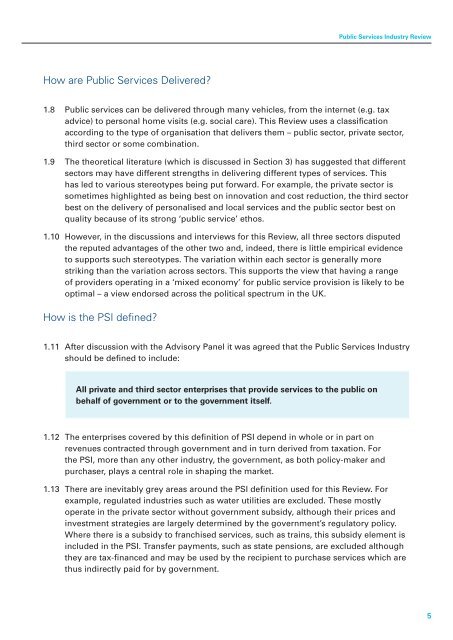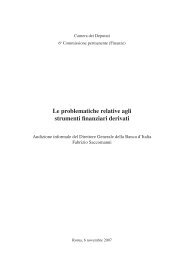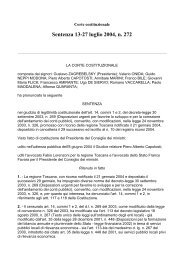Understanding the Public Services Industy
Understanding the Public Services Industy
Understanding the Public Services Industy
Create successful ePaper yourself
Turn your PDF publications into a flip-book with our unique Google optimized e-Paper software.
<strong>Public</strong> <strong>Services</strong> Industry Review<br />
How are <strong>Public</strong> <strong>Services</strong> Delivered?<br />
1.8 <strong>Public</strong> services can be delivered through many vehicles, from <strong>the</strong> internet (e.g. tax<br />
advice) to personal home visits (e.g. social care). This Review uses a classification<br />
according to <strong>the</strong> type of organisation that delivers <strong>the</strong>m – public sector, private sector,<br />
third sector or some combination.<br />
1.9 The <strong>the</strong>oretical literature (which is discussed in Section 3) has suggested that different<br />
sectors may have different strengths in delivering different types of services. This<br />
has led to various stereotypes being put forward. For example, <strong>the</strong> private sector is<br />
sometimes highlighted as being best on innovation and cost reduction, <strong>the</strong> third sector<br />
best on <strong>the</strong> delivery of personalised and local services and <strong>the</strong> public sector best on<br />
quality because of its strong ‘public service’ ethos.<br />
1.10 However, in <strong>the</strong> discussions and interviews for this Review, all three sectors disputed<br />
<strong>the</strong> reputed advantages of <strong>the</strong> o<strong>the</strong>r two and, indeed, <strong>the</strong>re is little empirical evidence<br />
to supports such stereotypes. The variation within each sector is generally more<br />
striking than <strong>the</strong> variation across sectors. This supports <strong>the</strong> view that having a range<br />
of providers operating in a ‘mixed economy’ for public service provision is likely to be<br />
optimal – a view endorsed across <strong>the</strong> political spectrum in <strong>the</strong> UK.<br />
How is <strong>the</strong> PSI defined?<br />
1.11 After discussion with <strong>the</strong> Advisory Panel it was agreed that <strong>the</strong> <strong>Public</strong> <strong>Services</strong> Industry<br />
should be defined to include:<br />
All private and third sector enterprises that provide services to <strong>the</strong> public on<br />
behalf of government or to <strong>the</strong> government itself.<br />
1.12 The enterprises covered by this definition of PSI depend in whole or in part on<br />
revenues contracted through government and in turn derived from taxation. For<br />
<strong>the</strong> PSI, more than any o<strong>the</strong>r industry, <strong>the</strong> government, as both policy-maker and<br />
purchaser, plays a central role in shaping <strong>the</strong> market.<br />
1.13 There are inevitably grey areas around <strong>the</strong> PSI definition used for this Review. For<br />
example, regulated industries such as water utilities are excluded. These mostly<br />
operate in <strong>the</strong> private sector without government subsidy, although <strong>the</strong>ir prices and<br />
investment strategies are largely determined by <strong>the</strong> government’s regulatory policy.<br />
Where <strong>the</strong>re is a subsidy to franchised services, such as trains, this subsidy element is<br />
included in <strong>the</strong> PSI. Transfer payments, such as state pensions, are excluded although<br />
<strong>the</strong>y are tax-financed and may be used by <strong>the</strong> recipient to purchase services which are<br />
thus indirectly paid for by government.<br />
5
















